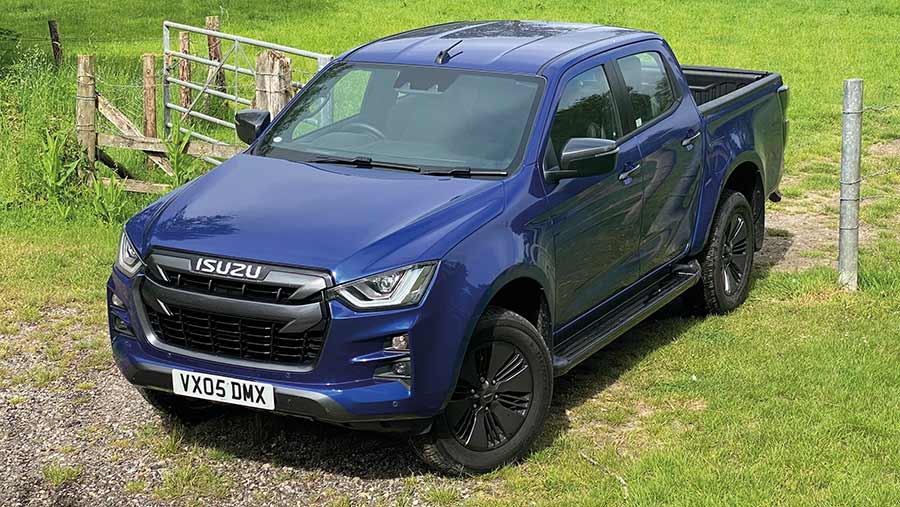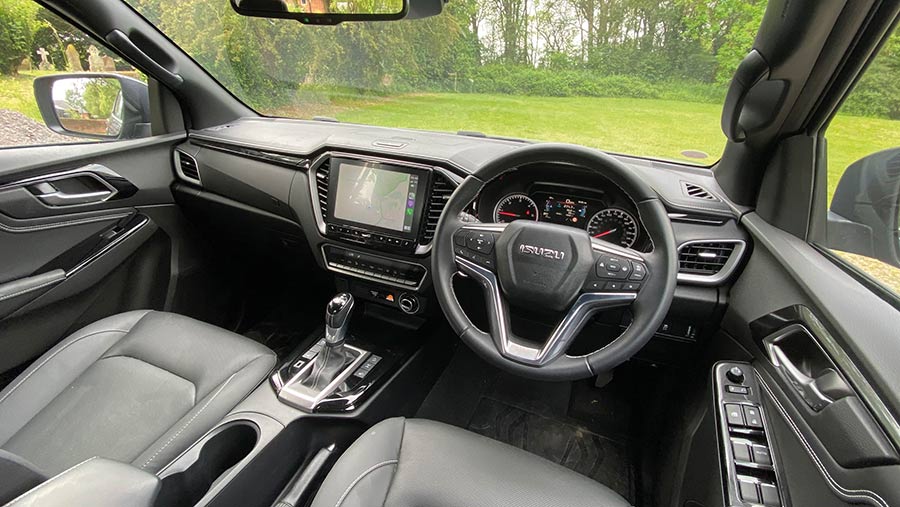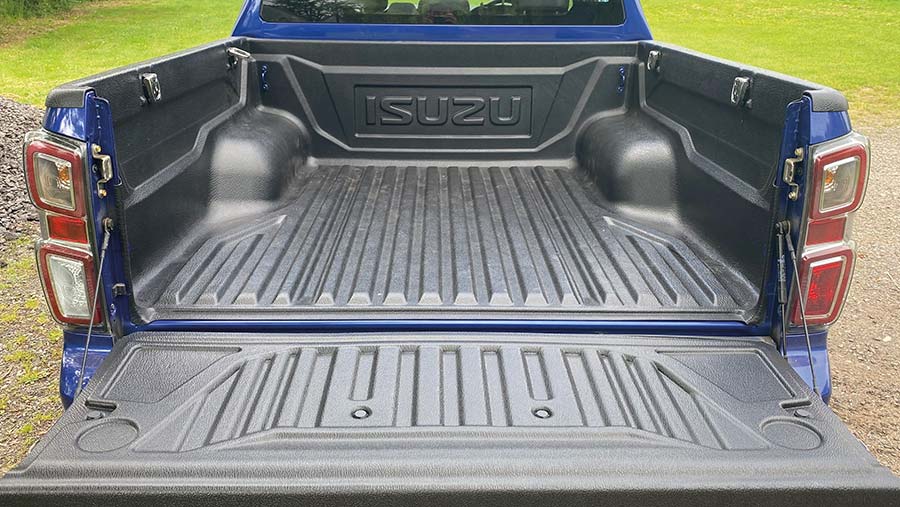On test: Isuzu D-Max V-Cross pickup
 Isuzu D-Max V-Cross © Oli Mark
Isuzu D-Max V-Cross © Oli Mark Isuzu has found its own little slot in the pickup market, with the D-Max traditionally operating at the austere end of the spectrum and, as such, offering farmers and builders a solid truck at a respectable price.
But the Japanese brand has decided to break rank by indulging in an extreme beautification exercise that it hopes will help attract bigger-spending buyers of the soon-to-be-gone Nissan Navara and Mitsubishi L200.
Evidence of the improvements can be seen across the board, where even the unpretentious Utility range, available in single-, extended- and double-cab formats, has been given a decent standard spec.
See also: Off-road vehicle four-wheel drive systems explained
Surprisingly, Isuzu expects them to be the lowest sellers, with the lion’s share taken up by the pair of mid-level DLs. These, as the name designation suggests, include a rear diff-lock as standard and bring more interior goodies and automated functions to the party, as well as the seemingly compulsory addition of chrome details and 18in alloys.
Top dog, and the model featured in this test, is the V-Cross. It is, by some margin, the most sophisticated and stylish D-Max produced to date, and makes its forebear, the Blade, look somewhat primitive (on the inside, at least).
Isuzu D-Max V-Cross
- Engine 1.9-litre, four-cylinder
- Power 164hp@3,600rpm
- Torque 360Nm@2,000-2,500rpm\
- Transmission Six-speed auto
- Max speed 112mph
- 0-62mph 13sec
- Combined consumption 30.7mpg
- Wheelbase 3,125mm
- Ground clearance 235mm
- Turning circle 13.09m (as tested)
- Kerb weight 2,030kg
- Payload 1,070kg
- Towing capacity 3,500kg
Engine and transmission
Behind the D-Max’s squinty nose is a 1.9-litre engine that was first introduced in 2017.
Its modest capacity has become something of a moot point among farming buyers, particularly those that intend to give it a good beasting with a stock trailer in tow. But Isuzu is hamstrung by European emissions limits and so cannot sell the 3-litre version that is available to other markets.
The firm’s four-cylinder is no match for its rivals, serving up just 164hp and 360Nm of torque. And that meagre output plays out as you’d expect, with the D-Max wheezing its way to a pedestrian 0-62mph time of 13sec. That’s over two seconds slower than the Hilux, which itself is no Linford Christie.
It also makes a lot of noise – of the rattly and slightly futile kind. Most of the pulling happens at 2,000-3,000rpm and the commotion calms beyond 3,500rpm, by which point the engine has little more to give. It feels handicapped by its limited capacity but that needn’t be the case – Ford gets far more from the 2-litre block in its Ranger, and sounds less Dachshund and more Dobermann in the process.
One driveline element that has improved is the marriage of engine and transmission. Shifts through the six-speed auto are, on paper, 25% quicker and the result is a serious upgrade on the dithery arrangement of old.
Gear selection is somewhat less decisive, with the D-Max retaining its habit of wandering up and down the range and delaying shifts until the engine has yapped for a few seconds too long. But for plenty of Isuzu buyers that will be irrelevant as manual gearboxes remain the dominant force (70:30 at the last count).
Economy is passable by pickup standards, with the official combined figure of 30.7mpg eminently achievable. We averaged 32mpg after a week of mixed driving and the manual version, driven carefully, is claimed to be even better (33.6mpg).
It can also be legally run at normal passenger car speed limits on single and dual carriageways, rather than the 10mph reduction that applies to the other pickups in this test. That’s thanks to its weight – it scrapes in below the 2,040kg threshold – so is considered a dual-purpose vehicle by the DVLA.
What does it cost (on the road price, ex VAT)?
- Utility double-cab – £24,509 (manual)
- DL20 double-cab – £26,759 (manual); £28,259 (auto)
- DL40 double-cab – £29,759 (manual); £31,259 (auto)
- V-Cross double-cab – £31,259 (manual); £32,759 (auto) (OTR price, ex-VAT)
Interior
Big changes here, where a fresh layout is hoped to be the gateway to a previously untapped, leisure-orientated market.
Stitched leather, soft-touch plastics and black gloss are easy on the eye, but do far too good a job of showing up dirt and greasy fingerprints.
The interior is not unlike that of the Ssangyong Musso – the one remaining UK pickup option not to feature in this test – which also neatly mixes textures to produce a smart look without ramping up costs.

© Oli Mark
The techy centrepiece is a new 9in touchscreen that no longer has the aftermarket feel of old but isn’t entirely easy to use. Saving grace is access to Apple CarPlay and Android Auto – a get-out-of-jail-free card for any vehicle maker reluctant to throw bundles of cash at software development. It means there’s little reason to go venturing into the screen, other than to access the DAB radio.
There’s also a bountiful supply of automated functions – something Isuzu has never previously bothered with.
As well as keyless entry, which is surprisingly handy, there are automatic lights and windscreen wipers for the first time. Add to that adaptive cruise control, automatic emergency braking, traffic sign recognition, blind spot monitors and lane departure warning, which were all major contributors to Isuzu bagging its first five-star Euro NCAP safety award.
Quick verdict
Isuzu has managed to significantly improve the D-Max’s interior without making it prohibitively expensive, but the updates do little to paper over the shortcomings of the engine and driveline. The V-Cross version is chock-full with techy goodies, though we reckon the mid-range DLs probably offer a better balance of spec and price.
- Price as tested £32,759
- Best for Manoeuvrability
- Worst for Engine performance
Off-road
The D-Max’s key working metrics remain as before, with a 3.5t towing limit and 1,070kg payload.
A few nips and tucks have seen overall length shrink by 30mm but, paradoxically, the wheelbase has been extended by the same length. This has allowed the designers to add a smidge of cabin space and 10mm to the load bed, making it a touch narrower and shorter than the Hilux.

© Oli Mark
The inclusion of a gas strut softens the tailgate drop, and a decent crop of lash down points includes four that pivot to protrude beyond the lip of the bed.
As for ride, Isuzu claims to have tweaked the rear leaf suspension and stiffened up the ladder chassis with an extra cross member and larger rails. There are also new cab mounts to absorb more noise and vibrations, but it’s difficult to discern any notable improvements.
It remains relentlessly jittery along rough farm tracks with no weight in the back to pin down the tail, though the shivering settles slightly when the suspension is properly activated over fiercer bumps.
The D-Max’s weight might be one factor to blame – at 2,030kg, it’s roughly 100kg lighter than the Hilux and almost 150kg less than the Ranger.
But it’s also modestly proportioned, and that helps deliver a handy turning circle. The steering is light, which is useful for slow manoeuvres, but means weight and feel is in short supply at speed.
Elsewhere, the rear diff-lock can be engaged below 5mph and with low range selected, which kicks out the ABS, traction control and hill descent system.
There’s also a new four-wheel drive actuator that quickens engagement of the rear driveshafts. It can be done on the fly via a dial on the centre console but, because there’s no central differential, can’t be run in 4wd on the road.
Likes and gripes
Likes
✅ Vastly improved interior finish
✅ Good turning circle
✅ Relatively compact size
Gripes
❌ Jittery ride
❌ Rattly engine
❌ Lacks power and speed

